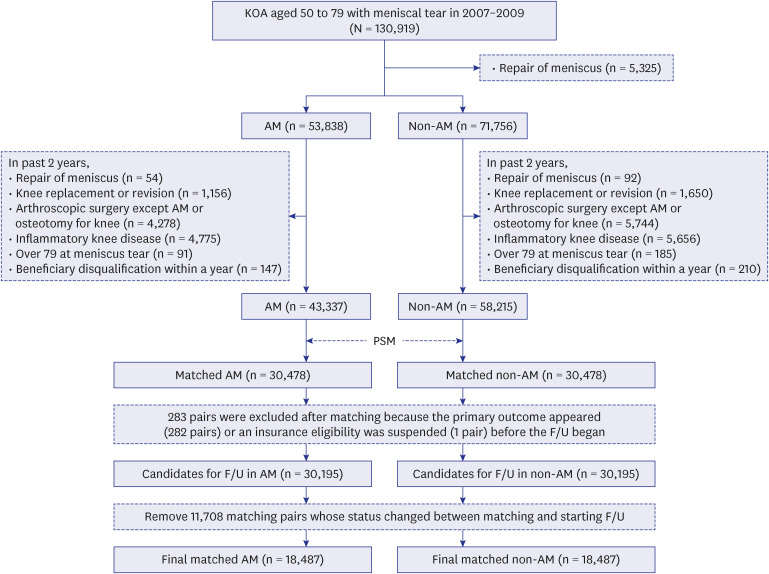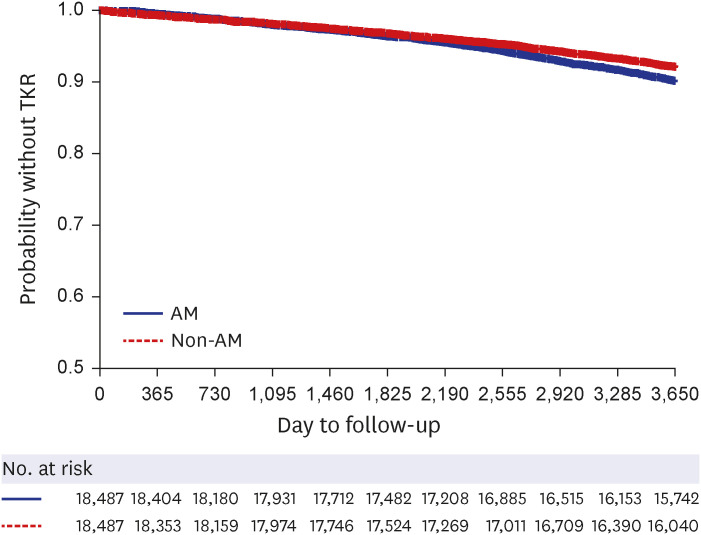J Korean Med Sci.
2023 Jan;38(1):e6. 10.3346/jkms.2023.38.e6.
Total Knee Replacement After Arthroscopic Meniscectomy in Knee Osteoarthritis: A Nationwide Population-Based Cohort Study
- Affiliations
-
- 1National Evidence-Based Healthcare Collaborating Agency, Seoul, Korea
- 2College of Nursing, Institute of Health Science Research, Inje University, Gimhae, Korea
- 3Department of Internal Medicine, Kangdong Sacred Heart Hospital, Hallym University College of Medicine, Seoul, Korea
- 4Division of Rheumatology, Department of Internal Medicine, Hallym University Sacred Heart Hospital, Anyang, Korea
- 5Institute for Skeletal Aging, Hallym University, Chuncheon, Korea
- KMID: 2537448
- DOI: http://doi.org/10.3346/jkms.2023.38.e6
Abstract
- Background
Recent studies raise concerns that arthroscopic meniscectomy (AM) for degenerative tear may be detrimental to the maintenance of the joint structure. This study was performed to examine the rate of total knee replacement (TKR) among patients with knee osteoarthritis (OA) who underwent AM for meniscal tears and compare this rate with those who did not.
Methods
A retrospective cohort study was conducted using the National Health Insurance Database of South Korea. Among knee OA patients aged 50–79, those who were treated with AM due to meniscal damage from 2007 to 2009 were selected as the AM group while those not treated with AM despite the presence of meniscal damage were selected as control group. Both were matched based on a propensity score and followed-up until the earliest occurrence of: TKR, death, or 10 years. Cox proportional hazards models were used to compare the outcome.
Results
A total of 36,974 patients were included in AM groups and non-AM group after 1:1 matching. TKR occurred in 9.62% and 7.64% in AM and non-AM groups with the average duration after meniscectomy of 5.88 ± 2.77 and 5.50 ± 2.94 years, respectively. After adjustment for baseline confounders, the TKR rate in the AM group was calculated to be 25% higher than that in the non-AM group (subdistribution hazard ratio, 1.25; 95% confidence interval, 1.16–1.34). The mortality rate was 5.20%, which did not significantly differ between groups.
Conclusion
OA patients who underwent AM for the meniscal injury had higher incidence of TKR up to 10 years of follow-up than the non-operated group. The greater TKR utilization observed in patients undergoing AM merits caution when treating OA patients with meniscal injury.
Keyword
Figure
Reference
-
1. Englund M, Guermazi A, Gale D, Hunter DJ, Aliabadi P, Clancy M, et al. Incidental meniscal findings on knee MRI in middle-aged and elderly persons. N Engl J Med. 2008; 359(11):1108–1115. PMID: 18784100.2. Bhattacharyya T, Gale D, Dewire P, Totterman S, Gale ME, McLaughlin S, et al. The clinical importance of meniscal tears demonstrated by magnetic resonance imaging in osteoarthritis of the knee. J Bone Joint Surg Am. 2003; 85(1):4–9. PMID: 12533565.3. Kim HA, Kim I, Song YW, Kim DH, Niu J, Guermazi A, et al. The association between meniscal and cruciate ligament damage and knee pain in community residents. Osteoarthritis Cartilage. 2011; 19(12):1422–1428. PMID: 21959098.4. Choi M, Lee SJ, Park CM, Ryoo S, Kim S, Jang JY, et al. Arthroscopic partial meniscectomy versus physical therapy for degenerative meniscal tear: a systematic review. J Korean Med Sci. 2021; 36(45):e292. PMID: 34811974.5. Thorlund JB, Juhl CB, Roos EM, Lohmander LS. Arthroscopic surgery for degenerative knee: systematic review and meta-analysis of benefits and harms. BMJ. 2015; 350:h2747. PMID: 26080045.6. Katz JN, Brophy RH, Chaisson CE, de Chaves L, Cole BJ, Dahm DL, et al. Surgery versus physical therapy for a meniscal tear and osteoarthritis. N Engl J Med. 2013; 368(18):1675–1684. PMID: 23506518.7. Sihvonen R, Paavola M, Malmivaara A, Itälä A, Joukainen A, Nurmi H, et al. Arthroscopic partial meniscectomy versus sham surgery for a degenerative meniscal tear. N Engl J Med. 2013; 369(26):2515–2524. PMID: 24369076.8. Chung KS, Ha JK, Kim YS, Kim JH, Ra HJ, Kong DH, et al. National trends of meniscectomy and meniscus repair in Korea. J Korean Med Sci. 2019; 34(32):e206. PMID: 31432650.9. Park JW. Higher meniscus surgery incidence in Korea compared to Japan or the USA. J Korean Med Sci. 2019; 34(32):e233. PMID: 31432655.10. Englund M, Roos EM, Roos HP, Lohmander LS. Patient-relevant outcomes fourteen years after meniscectomy: influence of type of meniscal tear and size of resection. Rheumatology (Oxford). 2001; 40(6):631–639. PMID: 11426019.11. Katz JN, Shrestha S, Losina E, Jones MH, Marx RG, Mandl LA, et al. Five-year outcome of operative and nonoperative management of meniscal tear in persons older than forty-five years. Arthritis Rheumatol. 2020; 72(2):273–281. PMID: 31429198.12. Seong SC, Kim YY, Khang YH, Heon Park J, Kang HJ, Lee H, et al. Data Resource Profile: the National Health Information Database of the National Health Insurance Service in South Korea. Int J Epidemiol. 2017; 46(3):799–800. PMID: 27794523.13. Park HR, Im S, Kim H, Jung SY, Kim D, Jang EJ, et al. Validation of algorithms to identify knee osteoarthritis patients in the claims database. Int J Rheum Dis. 2019; 22(5):890–896. PMID: 30729731.14. Farina EM, Lowenstein NA, Chang Y, Arant KR, Katz JN, Matzkin EG. Meniscal and mechanical symptoms are associated with cartilage damage, not meniscal pathology. J Bone Joint Surg Am. 2021; 103(5):381–388. PMID: 33448713.15. Petty CA, Lubowitz JH. Does arthroscopic partial meniscectomy result in knee osteoarthritis? A systematic review with a minimum of 8 years’ follow-up. Arthroscopy. 2011; 27(3):419–424. PMID: 21126847.16. Roemer FW, Kwoh CK, Hannon MJ, Hunter DJ, Eckstein F, Grago J, et al. Partial meniscectomy is associated with increased risk of incident radiographic osteoarthritis and worsening cartilage damage in the following year. Eur Radiol. 2017; 27(1):404–413. PMID: 27121931.17. Winter AR, Collins JE, Katz JN. The likelihood of total knee arthroplasty following arthroscopic surgery for osteoarthritis: a systematic review. BMC Musculoskelet Disord. 2017; 18(1):408. PMID: 28978308.18. Aprato A, Sordo L, Costantino A, Sabatini L, Barberis L, Testa D, et al. Outcomes at 20 years after meniscectomy in patients aged 50 to 70 years. Arthroscopy. 2021; 37(5):1547–1553. PMID: 33307147.19. Persson F, Turkiewicz A, Bergkvist D, Neuman P, Englund M. The risk of symptomatic knee osteoarthritis after arthroscopic meniscus repair vs partial meniscectomy vs the general population. Osteoarthritis Cartilage. 2018; 26(2):195–201. PMID: 29146386.



